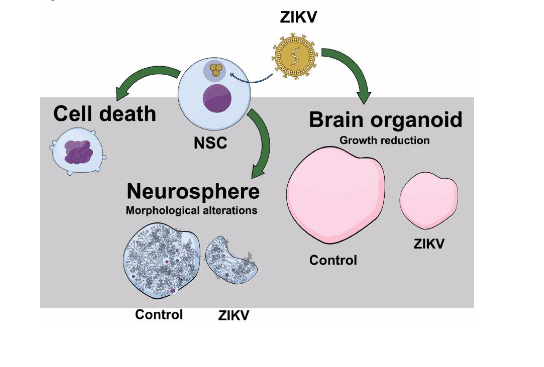Neurogenesis and Zika virus
Neurogenesis is the process by which neurons are generated from neural stem cells and progenitor cells. It is a crucial part of neural development and is most active during pre-natal life, being responsible for populating the growing brain with neurons.
Zika virus is an emerging mosquito-borne and sexually-transmitted flavivirus that was first identified in Uganda in 1947 through a monitoring network of sylvatic yellow fever in rhesus monkeys. It was named after the forest in Uganda where it was first identified. Five years later, the virus was subsequently detected in humans in Uganda and Tanzania and outbreaks of Zika virus disease have been recorded in Africa, the Americas, Asia and the Pacific. It is now reported to be circulating in 26 countries and territories in Latin America and the Caribbean. The World Health Organization declared a Public Health Emergency of International Concern on February 1 of 2016.

During large outbreaks in French Polynesia and Brazil in 2013 and 2015 respectively, health authorities reported potential neurological complications of Zika virus disease. In Brazil, local public health services have observed an increase in Guillain-Barré syndrome which coincides with Zika virus infections in the general population, as well as an increase in babies born with microcephaly in northeastern Brazil. Zika virus was detected in the amniotic fluid of two pregnant women whose fetuses had been diagnosed with microcephaly suggesting that this virus can cross the placental barrier. It has also been found in microcephalic fetal brain tissue.
New research, done independently by two groups, show that the virus readily infects neural stem cells –the precursors of neurons and other brain cells– whether they are grown on cell culture plates or coaxed to form neurospheres and cerebral organoids.
In the first study 1, researchers show that Zika virus can infect and kill human progenitor cells. This research team turned to human induced pluripotent stems cells (iPS cells), derived from skin biopsies, to produce human neural progenitor cells. Those progenitors cells are readily found in the developing brain and give rise to the cerebral cortex, a portion of the brain often affected in children with microcephaly. The group, lead by Guo-li Ming and Houngjun Song of Johns Hopkins University in Baltimore and Hengli Tang of Florida State University in Tallahassee, found that Zika virus could readily infect those neuronal progenitors in lab dishes. In fact, within three days of inoculation, the lab strain of virus had infected 65 to 90 % of the cells and they also led to a 30 % reduction in viable human neural progenitor cells since some cells died, other had interrupted cell division cycles, and other grew more slowly. The effect is specific since, in contrast, when the virus was applied to cultures of fetal kidney cells, embryonic stem cells, and undifferentiated iPS cells, it infected fewer than 10% of these cells by day 3. Immature neurons derived from the neural progenitor cells were also less susceptible to the infection, three days after receiving a dose of the virus, fewer than 20% of those cells were infected. The group also discovered that once infected, the human neural progenitor cells were not killed right away but turn into virus factories, i.e. the virus sequestered the cells’ own machinery to replicate and release more virus to infect more cells. That helped the virus to spread quickly throughout the cell population. Although more research is needed, including clinical studies, it is a clear evidence that Zika virus can directly affect neurogenesis and it also explain how could produce damage to the developing brain, suggesting a link to microcephaly.

In the second study 2, published in a non-reviewed format, neuroscientist Patricia Garcez and stem cell researcher Stevens Rehen at the D’Or Institute for Research and Education in Rio de Janeiro used neurospheres, a cluster of human neural stem cells, and 3D organoids, structures that resemble in some aspects the human brain. When they infected the growing cells with Zika virus isolated from a Brazilian patient, it was observed using immunocytochemistry and electron microscopy, that Zika virus targets human brain cells, reducing their viability and growth both in neurospheres and in the cerebral organoids. Zika virus infected neurospheres showed morphological abnormalities and cell detachment. After 6 days in vitro, hundreds of neurospheres have grown under mock conditions whereas in Zika virus infected neural stem cells only a few neurospheres survived. These results that Zika virus abrogates neurogenesis during human brain development. The infected organoids had final sizes half their control group.
Both Garcez and Song have declared to the press 3 that they are now repeating the studies with other viruses, including dengue, a virus closely related to Zika that is prevalent in the regions currently affected by the outbreak and that some scientists suspect is related to Zika virus damage. It is also necessary to figure out how the virus crosses the placenta and infect the fetus directly, something most viruses are unable to do.
References
- Tang H, Hammack C, Ogden SC, Wen Z, Qian X, Li Y, Yao B, Shin J, Zhang F, Lee EM, Christian KM, Didier RA, Jin P, Song H, Ming G (2016) Zika Virus Infects Human Cortical Neural Progenitors and Attenuates Their Growth. Cell Stem Cell Mar 4. ↩
- Garcez PP, Loiola EC, Madeiro da Costa RF, Higa L, Trindade P, Delvecchio R, Nascimento JM, Brindeiro RM, Tanuri A, Stevens K, Rehen SK (2016) Zika virus impairs growth in human neurospheres and brain organoids. PeerJ Preprints 4: e1817v3 ↩
- Vogel G (2016) Zika virus kills developing brain cells. Science Mag ↩
1 comment
[…] Neurogenesis and Zika virus […]